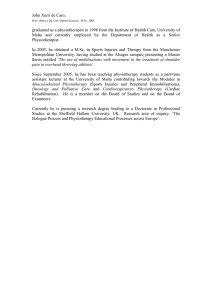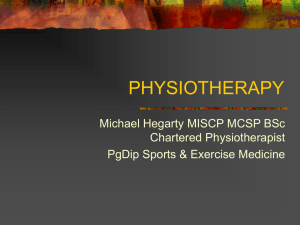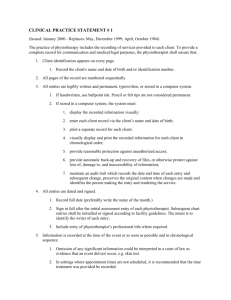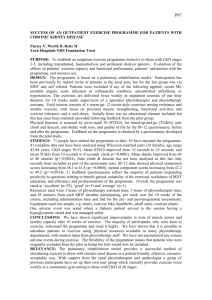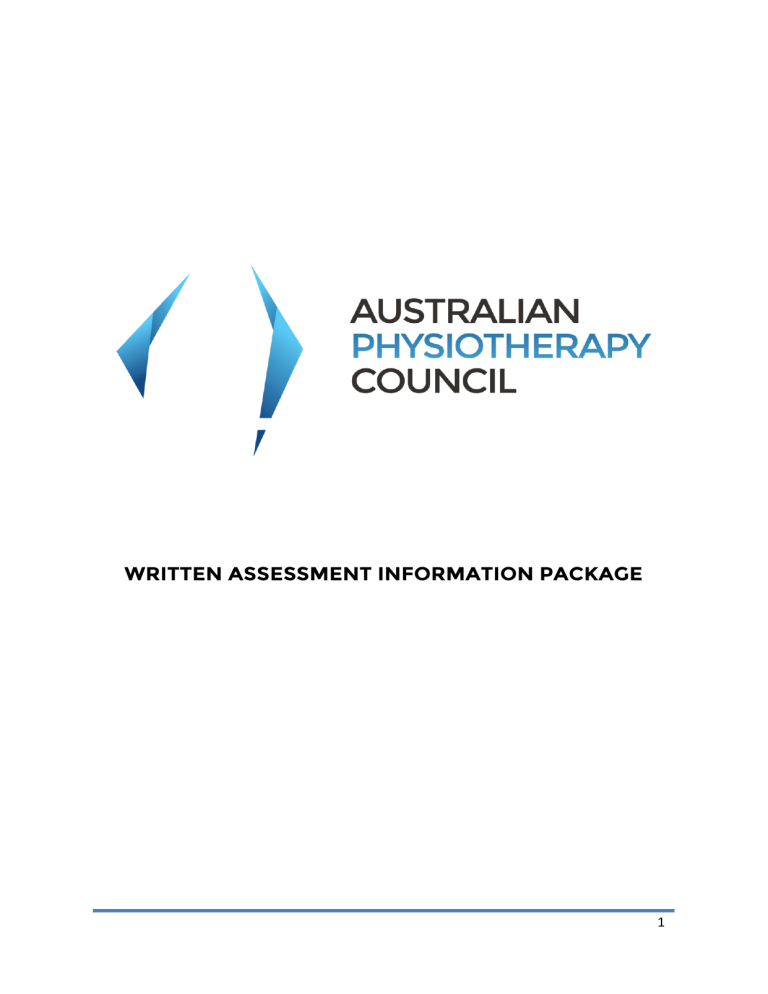
WRITTEN ASSESSMENT INFORMATION PACKAGE 1 Two papers, one examination The examination has two papers (Paper 1 and Paper 2). The examination is conducted over two sessions each of two hours duration, one in the morning (Paper 1) and one in the afternoon (Paper 2) of the same day. Each paper has 15 cases totalling 30 cases. The cases are drawn from the key areas of clinical practice (musculoskeletal, cardiorespiratory and neurology), across the lifespan including paediatrics and across health care settings. Details of the test content are included in this package. You should prepare by becoming familiar with the content and how the Elements are applied to each area. Each case has 4 multiple-choice items. You are required to choose the one correct response to each item from a list of 4 possible responses. Once you have chosen either a), b), c) or d) you blacken the appropriate oval on the generalised answer sheet using a pencil. There are 60 multiple-choice items on each paper. How will the responses be scored? The multiple choice answer sheets are marked electronically. You receive one mark for each correct response, zero for items you do not attempt, zero for incorrect responses and zero when you give more than one response for an item. What happens to your results? If you score 66 or more items correctly, you will be invited to progress to the clinical assessment. If you score between 54-65 items correctly you may be invited to a second sitting of the written examination. If you score below 54 items correctly, your candidature will end. Before the test You can prepare for the APC written examination. You should: Know the Elements of the Standards. Know the content areas being assessed. Know the procedures for the test. Prepare yourself mentally and physically. What to expect on the day The Written Assessment is scheduled and supervised by the IA Solutions. You must ensure you are familiar with all the information provided to you about the venue, identification checks and conduct of the examination. 2 At each examination venue, there will be a supervisor who will provide you with specific instructions for each session. There may be candidates from several other disciplines at the same examination venue who receive different instructions to you. Please ensure you follow the appropriate instructions. You will receive a copy of the examination paper, the generalised answer sheet and pencils. You should not take any material into the examination. At the completion of the examination, follow the instructions of the supervisor. You must not remove any material from the room. The instructions for the examination are shown on the first page of the examination paper as shown in the sample below. 3 PAPER 1 SAMPLE Candidate Name.........……………………………….. AUSTRALIAN PHYSIOTHERAPY COUNCIL WRITTEN EXAMINATION SEPTEMBER, 2012 PAPER 1 INSTRUCTIONS TO CANDIDATES 1. Candidates have two (2) hours to complete the paper. 2. Candidates must complete the top section of the Generalised Answer Sheet as shown in the example on the following page. 3. Candidates must write their name at the top of this page in the space indicated. 4. This paper consists of fifteen (15) case studies each with four (4) accompanying multiple choice questions giving a total of sixty (60) questions to be answered. 5. Candidates are expected to choose the one (1) correct response and record their choice (in pencil) on the Generalised Answer Sheet provided. Please use the reverse side of the Generalised Answer Sheet for responses to question 51 onwards. 6. Candidates may use the examination paper to make notes. 7. The examination paper and the response sheet must be handed to the supervisor. 8. All case studies and multiple choice questions carry equal marks. 9. This paper consists of twenty-six (26) pages. 4 5 Examination papers There are 15 cases on each paper. Each case describes a patient by name (e.g. Mrs X or by first name if a child), gender and age and identifies the clinical setting in which the physiotherapist is seeing the patient. The presentation of the patient at a particular point is identified. Some cases contain very detailed information about clinical assessment findings while others describe only a small amount of information. The amount of information presented is relevant to the items for the case. There are four items (questions) for each case. Each item poses a problem which requires you as the physiotherapist to identify the correct response (answer). The language of each item reflects the specific nature of the problem and how it should be addressed. The items consider knowledge, actions, decisions and responses that a physiotherapist would demonstrate in the clinical setting. The four items for each case are arranged in a sequence to reflect the order in which the problems would be addressed by a physiotherapist during their interaction with that patient. The interaction with the patient may occur within one time period or the case may extend across a specified period. Where the case is extended, additional information may be added and the application of the information for the subsequent items is clearly indicated. There are two sample cases on the following pages. Case 1 6 Lachie is a 4 year old boy who is attending a follow-up outpatient appointment at a Regional Hospital following an acute episode of asthma which occurred after playing at a friend’s place. Lachie received medication to relieve the acute episode which was effective. The doctor prescribed a home management program to Lachie’s mother and asked her to return for outpatient physiotherapy. It is now one week since the initial episode and Lachie’s mother has some questions about Lachie’s condition. 1. Lachies’ mother asks the physiotherapist “Can you tell me what asthma is?” Which of the following responses should the physiotherapist give? a) b) c) d) 2. Lachies’ mother asks the physiotherapist “What is the advantage of the spacer?” Which response should the physiotherapist give? a) b) c) d) 3. “It makes the medication spread better in the airways.” “It allows faster administration of the medication.” “It prevents coughing while taking the medication.” “It prevents candida infection in the throat.” Lachie’s mother wants to know how she will be able to tell if the asthma is under control. How should the physiotherapist describe the likely symptoms of poor asthma control in Lachie? a) b) c) d) 4. “The airways in the lungs are less sensitive than normal.” “The airways in the lungs are more sensitive than normal.” “There is an infection in the lungs.” “The muscles of the airways are weak.” He will sleep more than usual. He will struggle with normal activity. He will complain of feeling nauseous. His pulse will slow down. The childcare worker at Lachies’ day care has asked for specific information about his medications and how they are to be administered. Which communication method should the physiotherapist use to provide information to the day care? a) b) c) d) Email. Telephone call. Written management plan. Face to face appointment. Case 2 7 Mr R is 48 years old and runs a large information technology firm. He is married with three school aged children and enjoys a comfortable lifestyle. He enjoys long mountain bike rides on weekends but does not exercise during the week due to work commitments. At a recent health assessment he: had a BMI of 30. had blood pressure reading at rest of 136/88 mmHg. achieved a maximal heart rate of 170 beats per minute and was noted to have above average fitness for his age. He has been referred to a multidisciplinary team including physiotherapy for preventative management. 5. What does a BMI of 30 indicate to the physiotherapist about Mr R? a) b) c) d) 6. Mr R asks the physiotherapist what is the target blood pressure for people at risk of coronary heart disease. What should the physiotherapist tell him? a) b) c) d) 7. underweight normal overweight obese < 180/110mmHg < 160/100mmHg < 130/80mmHg ≤ 120/60mmHg What percentage of maximal heart rate should the physiotherapist recommend Mr R maintain while exercising? a) 50 - 60% b) 60 - 70% c) 70 - 80% d) 80 - 90% 8 8. Mr R is confused about the roles of the various health professionals in the multidisciplinary team. What should the physiotherapist tell Mr R is the role of the physiotherapist in the cardiac clinic? a) b) c) d) Assessment and management of patients physical needs. Behavioural management and counselling. Design and implementation of weight loss programs. Monitoring of coronary heart disease risk factors. 9 Question Answer 1 b 2 a 3 b 4 c 5 d 6 c 7 b 8 a 10 What else do you need to know? 1. Elements of the Standards The items in the written examination are designed to test the elements identified in the Australian Physiotherapy Standards that are indicated in this table with a tick (√ =included). Elements which are crossed (X =excluded) are not tested in the written examination. This table should be read in conjunction with the Australian Standards for Physiotherapy Published July 2006 – a copy is available for download on the website or can be purchased from the Australian Physiotherapy Council. Where an element has an asterisk, further information is provided. Standard 1. Demonstrate professional behaviour appropriate to physiotherapy 2. Communicate effectively 3. Access, interpret and apply information to continuously improve practice 4. Assess the client 5. Interpret and analyse the assessment findings 6. Develop a physiotherapy intervention plan Element 1.1 Demonstrate practice that is ethical 1.2 Demonstrate strategies to maintain and extend professional competence 1.3 Operate within individual and professional strengths and limitations 2.1 Communicate effectively with the client 2.2 Adapt communication style recognising cultural safety and diversity’ 2.3 Communicate effectively with other service providers 2.4 Prepare and deliver presentations to groups 2.5 Prepare and provide documentation according to legal requirements 3.1 Demonstrate a working knowledge and understanding of theoretical concepts and principles relevant to physio practice 3.2 Apply contemporary forms of information management 3.3 Apply an evidence based approach to practice 3.4 Acquire and apply new knowledge to continuously improve own practice 4.1 Collect client information 4.2 Form a preliminary hypothesis 4.3 Design and conduct an assessment 4.4 Conduct assessment safely 5.1 Compare the findings with ‘normal’ 5.2 Compare findings with what is expected for the condition, and include or exclude alternative diagnoses 5.3 Prioritise client needs 5.4 Re-evaluate as required to develop a justifiable and sustainable hypothesis 5.5 Identify areas that are outside skills and expertise and refer clients appropriately 6.1 Develop rationale for physiotherapy intervention 6.2 Set realistic short and long term goals with the client 6.3 Select appropriate intervention 6.4 Plan for possible contingencies that may affect intervention plan 11 X X √ √ X √ X √ √ X √ X √ √ √ √ √ √ √ √ √ √ √ √ √ 6.5 6.6 7. Implement safe and effective physiotherapy intervention(s) 8. Evaluate the effectiveness and efficiency of physiotherapy intervention(s) 9. Operate effectively across a range of settings 7.1 7.2 7.3 7.4 7.5 7.6 8.1 8.2 8.3 9.1 9.2 9.3 9.4 9.5 2. Prioritise intervention plan in collaboration with the client Determine plan of evaluation that uses valid and reliable outcome measures Obtain informed consent for the intervention Prepare equipment and treatment are appropriate to the intervention Implement intervention safely and effectively Manage adverse events Provide strategies for client self management Implement health promotion activities Monitor the outcomes of the intervention Evaluate the outcomes of the intervention Determine modifications to intervention √ √ Use a model of service delivery relevant to the practice setting Work effectively with a team Manage work schedule to maximise safety, efficiency and effectiveness Operate within own role and according to responsibilities Participate in quality improvement processes √ √ √ √ X √ √ √ √ √ √ X √ X Conditions that are commonly managed independently by entry level physiotherapists Musculoskeletal Muscle contusions/strains/tears/weakness Ligament sprains/tears Tendonopathy, tendon ruptures/tears, tendonosis Fasciitis Joint derangements/dysfunction (e.g., loose bodies, hypermobility, hypomobility) Fractures, dislocations, subluxations Osteoporosis/osteopenia Tumour/pathological fractures Degenerative joint disease Mechanical spinal abnormalities (e.g., low back pain, scoliosis, postural dysfunction) Inflammatory/infectious conditions of the neuromusculoskeletal system Amputations Congenital malformations (e.g., talipes equinovarus, hip dysplasia) Nerve compression (e.g., Carpal Tunnel Syndrome, radiculopathy, spinal stenosis) Peripheral nerve injuries Neural tissue dysfunction/neuro-dynamic dysfunction Cardiorespiratory Heart disease/malformation/injury (e.g., arteriosclerosis, blunt trauma, tamponade, aortic aneurysm) 12 Myocardial ischaemia and infarction (including surgical interventions) Heart failure, cor pulmonale Tumour Pneumonia (primary or post-operative/preventive) Atelectasis (primary or post-operative/preventive) Adult/infant respiratory distress syndrome (e.g., acute lung injury) Asthma Chronic obstructive pulmonary disease (e.g., emphysema, bronchitis, bronchiectasis) Restrictive pulmonary disease (e.g., fibrosis) Tuberculosis Pleural effusion Pulmonary oedema Cystic fibrosis Peripheral arterial disease Venous disorders Post abdominal/thoracic surgery Neurology 3. Cerebral Vascular Accident/transient ischemic attack Acquired brain injury Tumour Degenerative neurological/neuromuscular disorders (e.g., muscular dystrophies, amyotrophic lateral sclerosis, Parkinson disease) Demyelinating disorders (e.g., multiple sclerosis) Inflammatory/infectious conditions of nervous system (e.g., meningitis) Cerebellar disorders Neuropathies (e.g., peripheral neuropathies) Developmental/birth injuries (e.g., cerebral palsy) Dementia, affective and cognitive disorders What an entry level physiotherapist is expected to know about pharmacology Basic principles of pharmacology The names of commonly used drugs, mechanism of action, uses/indications, dosage, side effects, contra-indications of the drug groups listed below in the context of physiotherapy in Australia; Methods of drug administration including iontophoresis, injection, inhalation, etc. Drug Groups Commonly used drugs in the context of physiotherapy practice in Australia: Autonomic nervous system 13 - adrenergics - adrenergic blockers - cholinergics - cholinergic blockers CNS - anti Parkinsonian drugs - anti convulsants - opioid analgesics - non-opioid analgesics Cardiovascular - antiarrhythmic - antihypertensive drugs - anticoagulant drugs - anti anginal drugs Respiratory - bronchodilators - corticosteroids - mucolytics and expectorants - asthma prophylaxis Musculoskeletal and anti-inflammatory - skeletal muscle relaxants - anti-inflammatory drugs (including non-steroidal) - osteoporosis therapy - neuromuscular paralytic agent (Botulinum Toxin) Urinary system - diuretics Other - classes of antibiotics 4. What interventions are common for entry level physiotherapists to practice Exercise with or without equipment (e.g. passive, active assisted, active, resisted, neuromuscular, muscle patterning, PNF) 14 Joint mobilization Soft tissue techniques (e.g., massage, friction, stretching) Fitness/conditioning/endurance exercise programs Functional activity training Posture training Positioning Gait/mobility education and training with or without equipment Neurodynamic techniques (e.g. nerve gliding exercises) Balance training/proprioceptive training Sensory training (e.g. desensitization, protective education, sensory integration) Techniques to optimize oxygen transport and facilitate airway clearance (e.g., positioning, suctioning, secretion clearance, forced expiratory techniques) Mechanical agents (e.g. traction, continuous passive movement, compression garment and devices) Conductive thermal agents (e.g., contrast baths, paraffin wax, hot packs, ice/cold) Electrical agents (e.g. EMG biofeedback, transcutaneous electrical nerve stimulation [TENS], neuromuscular electrical nerve stimulation [NMES], interferential current [IF],) Electromagnetic energy agents (e.g. shortwave diathermy, ultraviolet) Acoustic agents (e.g. ultrasound) Protective, adaptive, or assistive devices (e.g. tape, splints, orthotics, prostheses) Recognize and respond to the adverse effects of intervention (e.g. pain, deterioration in client status) and/or non-adherence 5. Areas of practice are NOT included in the APC Written Examination Conditions HIV/Aids Burns Acute traumatic spinal cord injuries (Please note that patients with spinal cord problems resulting from tumour or congenital changes can be included) Settings Intensive care units with patients who are ventilated 15 6. Summary of APC Written Examination Content 2015 Assessment Further information to be advised Interpretation Further information to be advised (x) Clinical area Musculoskeletal: Cardiorespiratory: Neurology: (x) Elements Planning Further information to be advised Implementation Further information to be advised (x) (x) Evaluation Further information to be advised (x) Casemix Adult (36) Paeds (4) Adult (36) Paeds (4) Adult (36) Paeds (4) (x) number of items 16

